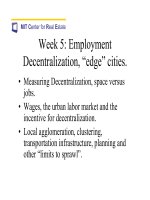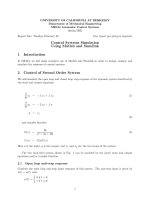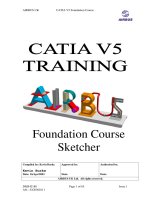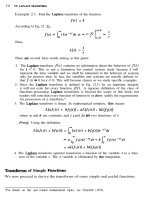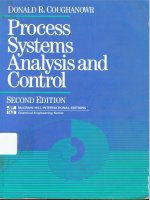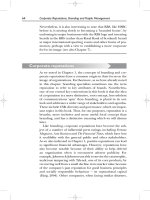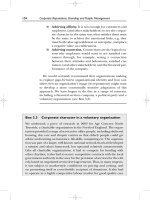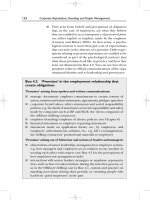Tài liệu Mechatronic Systems Modelling and Simulation with HDLs docx
Bạn đang xem bản rút gọn của tài liệu. Xem và tải ngay bản đầy đủ của tài liệu tại đây (2.97 MB, 234 trang )
Mechatronic Systems
Modelling and Simulation with HDLs
Georg Pelz
Infineon Technologies, Munich, Germany
Translated by
Rachel Waddington
Member of the Institute of Translation and Interpreting
First published under the title Modellierung und Simulation mechatronischer Systeme — vom
Chip zum Systementwurf mit Hardwarebeschreibungssprachen
H
¨
uthig-Verlag, Heidelberg, 2001
All Rights reserved
Authorized translation from German language edition published by H
¨
uthig-Verlag
Copyright
2003 John Wiley & Sons Ltd, The Atrium, Southern Gate, Chichester,
West Sussex PO19 8SQ, England
Telephone (+44) 1243 779777
Email (for orders and customer service enquiries):
Visit our Home Page on www.wileyeurope.com or www.wiley.com
All Rights Reserved. No part of this publication may be reproduced, stored in a retrieval system or transmitted in
any form or by any means, electronic, mechanical, photocopying, recording, scanning or otherwise, except under
the terms of the Copyright, Designs and Patents Act 1988 or under the terms of a licence issued by the
Copyright Licensing Agency Ltd, 90 Tottenham Court Road, London W1T 4LP, UK, without the permission in
writing of the Publisher. Requests to the Publisher should be addressed to the Permissions Department, John
Wiley & Sons Ltd, The Atrium, Southern Gate, Chichester, West Sussex PO19 8SQ, England, or emailed to
, or faxed to (+44) 1243 770620.
This publication is designed to provide accurate and authoritative information in regard to the subject matter
covered. It is sold on the understanding that the Publisher is not engaged in rendering professional services. If
professional advice or other expert assistance is required, the services of a competent professional should be
sought.
Other Wiley Editorial Offices
John Wiley & Sons Inc., 111 River Street, Hoboken, NJ 07030, USA
Jossey-Bass, 989 Market Street, San Francisco, CA 94103-1741, USA
Wiley-VCH Verlag GmbH, Boschstr. 12, D-69469 Weinheim, Germany
John Wiley & Sons Australia Ltd, 33 Park Road, Milton, Queensland 4064, Australia
John Wiley & Sons (Asia) Pte Ltd, 2 Clementi Loop #02-01, Jin Xing Distripark, Singapore 129809
John Wiley & Sons Canada Ltd, 22 Worcester Road, Etobicoke, Ontario, Canada M9W 1L1
Wiley also publishes its books in a variety of electronic formats. Some content that appears
in print may not be available in electronic books.
Library of Congress Cataloging-in-Publication Data
Pelz, Georg, 1962-
[Modellierung und Simulation mechatronischer Systeme. English]
Mechatronic systems : modelling and simulation with HDLs / George Pelz.
p. cm.
Includes bibliographical references and index.
ISBN 0-470-84979-7 (alk. paper)
1. Mechatronics. 2. Computer hardware description languages. I. Title.
TJ163.12.P4513 2003
621–dc21
2002192433
British Library Cataloguing in Publication Data
A catalogue record for this book is available from the British Library
ISBN 0-470-84979-7
Typeset in 10.5/13pt Times by Laserwords Private Limited, Chennai, India
Printed and bound in Great Britain by Antony Rowe Ltd, Chippenham, Wiltshire
This book is printed on acid-free paper responsibly manufactured from sustainable forestry
in which at least two trees are planted for each one used for paper production.
Contents
Preface xi
1 Objective and Motivation 1
1.1 Introduction 1
2 Principles of Modelling and Simulation 5
2.1 Introduction 5
2.2 Model Categories 8
2.3 Fields of Application 9
2.3.1 Introduction 9
2.3.2 Bottom-up design 9
2.3.3 Top-down design 10
2.3.4 Relationship of design strategies to modelling 12
2.3.5 Modelling for the specification 12
2.3.6 Modelling for the design 13
2.4 Model Development 14
2.4.1 Introduction 14
2.4.2 Structural modelling 16
2.4.3 Physical modelling 18
2.4.4 Experimental modelling 20
2.5 Model Verification and Validation 24
2.5.1 Introduction 24
2.5.2 Model verification 24
2.5.3 Model validation 27
2.6 Model Simplification 32
2.7 Simulators and Simulation 33
2.7.1 Introduction 33
2.7.2 Circuit simulation 33
2.7.3 Logic simulation 34
2.7.4 Multibody simulation 35
2.7.5 Block diagram simulation 36
vi CONTENTS
2.7.6 Finite element simulation 36
2.7.7 Software simulation 36
2.8 Summary 37
3 Modelling and Simulation of Mixed Systems 39
3.1 Introduction 39
3.2 Electronics and Mechanics 40
3.2.1 Introduction 40
3.2.2 Analogies 41
3.2.3 Limits of the analogies 43
3.2.4 Differences between electronics and mechanics 44
3.3 Model Transformation 45
3.3.1 Introduction 45
3.3.2 Circuit simulation 45
3.3.3 Logic/Petri net simulation 47
3.3.4 Multibody simulation 50
3.3.5 Finite-element simulation 51
3.3.6 Evaluation of the model transformation 51
3.4 Domain-Independent Description Forms 52
3.4.1 Bond graphs 52
3.4.2 Block diagrams 54
3.4.3 Modelling languages for physical systems 55
3.4.4 Evaluation of domain-independent description forms 57
3.5 Simulator Coupling 58
3.5.1 Introduction 58
3.5.2 Simulator backplane 58
3.5.3 Examples of the simulator coupling 60
3.5.4 Evaluation 62
3.6 Summary 62
4 Modelling in Hardware Description Languages 63
4.1 Introduction 63
4.2 Fields of Application 65
4.2.1 Formulation of specification and design 65
4.2.2 Validation of specifications and verification of designs 65
4.2.3 Automatic synthesis 66
4.3 Characterisation of Hardware Description Languages 66
4.4 Languages 68
4.5 Modelling Paradigms 69
CONTENTS vii
4.5.1 Introduction 69
4.5.2 Structural and behaviour-oriented modelling 70
4.5.3 Digital modelling 71
4.5.4 Analogue modelling 74
4.6 Simulation of Models in Hardware Description Languages 79
4.7 Summary 81
5 Software in Hardware Description Languages 83
5.1 Introduction 83
5.2 Simulation of Hardware for the Running of Software 85
5.3 Co-simulation by Software Interpretation 85
5.4 Co-simulation by Software Compilation 88
5.4.1 Introduction 88
5.4.2 Software representation 89
5.4.3 Synchronisation 90
5.4.4 Example of software modelling 92
5.4.5 Debugging of software 98
5.5 Summary 98
6 Mechanics in Hardware Description Languages 99
6.1 Introduction 99
6.2 Multibody Mechanics 100
6.2.1 Introduction 100
6.2.2 System-oriented modelling 104
6.2.3 Object-oriented modelling 108
6.2.4 Example: wheel suspension 111
6.2.5 Further applications 113
6.3 Continuum Mechanics 115
6.3.1 Introduction 115
6.3.2 Structural modelling 116
6.3.3 Physical modelling 125
6.3.4 Experimental modelling 130
6.4 Summary 132
7 Mechatronics 135
7.1 Modelling of Mechatronic Systems 135
7.2 Demonstrator 1: Semi-Active Wheel Suspension 136
7.2.1 System description 136
7.2.2 Modelling of software 138
viii CONTENTS
7.2.3 Modelling of mechanics 139
7.2.4 Simulation 140
7.3 Demonstrator 2: Internal Combustion Engine with Drive Train 143
7.3.1 System description 143
7.3.2 Modelling 145
7.3.3 Simulation 147
7.4 Demonstrator 3: Camera Winder 148
7.4.1 Introduction 148
7.4.2 System description 148
7.4.3 Modelling 148
7.4.4 Simulation 152
7.5 Demonstrator 4: Disk Drive 152
7.5.1 Introduction 152
7.5.2 The disk drive 153
7.5.3 Circuit development for disk drives 154
7.5.4 The virtual disk drive 157
7.5.5 System modelling 158
7.5.6 Simulation and results 159
7.5.7 Conclusion 160
7.5.8 Acknowledgement 161
7.6 Summary 161
8 Micromechatronics 163
8.1 Modelling Micromechatronic Systems 163
8.1.1 Introduction 163
8.1.2 Component design 164
8.1.3 System design 165
8.2 Demonstrator 5: Capacitive Pressure Sensor 166
8.2.1 System description 166
8.2.2 Modelling 168
8.2.3 Simulation 176
8.3 Demonstrator 6: Micromirror 182
8.3.1 System description 183
8.3.2 Modelling 183
8.3.3 Simulation 186
8.4 Summary 186
9 Summary and Outlook 187
Literature 189
CONTENTS ix
Appendix 217
Symbols 217
Abbreviations 220
Registered Trademarks 220
Index 221
This Page Intentionally Left Blank
Preface
Most of this work came into being during my employment at the Chair for Electron
Devices and Circuits in the Electronics Engineering department of the Gerhard-
Mercator University, Duisburg. Section 7.5 covers material that I have worked on
for my current employer, Infineon Technologies.
At this point I would like to express my gratitude for the support that I received
from many sides. My special thanks go to Prof. Dr. G. Zimmer, in whose depart-
ment I was able to work continuously for many years on the subject of this book,
and who helped me in many ways in the process. Moreover, I would like to thank
Prof. Dr. M. Glesner for his support of the work.
I would also like to thank my colleagues at the Gerhard-Mercator Univer-
sity, Duisburg, the Fraunhofer Institut IMS and Infineon Technologies, who pro-
vided a great deal of assistance in the form of discussions and suggestions dur-
ing the preparation of the book. The following in particular should be men-
tioned: Dr. J. Bielefeld, Dr. M. Leineweber, Dipl Ing. A. L
¨
udecke and Dipl Ing.
L. Voßk
¨
amper.
Apart from the technical side, I would like to express my thanks to Tilmann
Leopold. Last, but not least, I thank my family for their encouragement and support
during the composition of this book.
Ebersberg, January 2003 Georg Pelz (
)
This Page Intentionally Left Blank
1
Objective and Motivation
1.1 Introduction
The objective of this work was to support the design of mechatronic systems by the
use of simulations. This raises the question of what exactly is mechatronics. Current
definitions describe mechatronics as an interaction between electronics, mechanics
and information technology, see Isermann [164] or Wallaschek [421]. It makes no
difference here whether we are talking about macromechanics or micromechanics.
In the former case we speak of mechatronics, in the latter of micromechatronics or
microelectromechanical systems (MEMS). As was discovered during the course of
this project, although the dimensions of the mechanics in the systems under inves-
tigation may vary, the methods used for modelling and simulation are largely the
same, which makes the joint consideration of macromechanics and micromechanics
an obvious approach.
Why is the modelling and simulation of mechatronic systems difficult? First of
all, the field of mechatronics incorporates very different domains and similarly var-
ied methods of description. The field of electronics includes analogue and digital,
as well as continuous and event-oriented, processes. The same is true of mechan-
ics, although often for totally different reasons. In the field of mechanics, events
may, for example, be triggered by the transition from static to sliding friction. In
electronics, on the other hand, an event is brought about by the flicking of a switch,
triggering a connection to the entire digital world. In mechanics we also have to
deal with geometric aspects in three spatial dimensions. Furthermore, multibody
and continuum mechanics of different representational forms also have to be taken
into account. Finally, software can be considered as information in bistable cir-
cuits and thus classified as electronics. However, this is not sufficient to achieve
an efficient and transparent consideration, which means that we have to develop
our own m odels for the software.
The development of models is thus a difficult process at the best of times and
one which is prone to errors. However, a systematic verification and validation of
the model is not in sight. As in other fields of simulation, models containing errors
can produce arbitrary results. Recognising such errors is often not a simple matter.
Mechatronic Systems Georg Pelz
2003 John Wiley & Sons, Ltd ISBN: 0-470-84979-7
2 1 OBJECTIVE AND MOTIVATION
This is particularly true if the simulation relates to the design of a technical system
and its task is to make predictions about the system’s functionality. In this case
the system in question does not exist at all in the real world, which means that no
measurements are available for checking the model. Rather, the design has yet to
be investigated and completed. So proving the correctness of a model is a matter
of importance. If we now interpret — as did Butterfield in [55] — a model as a
scientific theory, then the validation of t he model must be placed within narrow
boundaries. According to Popper [338] the following is true for the validation of
a theory:
In order to be scientific, a theory must be falsifiable. It must be empirically testable,
at least in principle, and there must be a test that disproves the theory in the event
of a negative outcome.
There can never be a rigorous validation of a scientific theory. The best that we
can do is to develop empirical tests for the theory — fair tests, but the stricter the
better — and to hold onto the theory only as long as it has passed all tests.
The same applies for the validation of models. We can develop as many tests for a
model as we like, but this does not prove the validity of the model. A t best, trust
in a model increases with the number of tests.
Depending upon the problem to be solved, we can differentiate between two fun-
damental starting points in the simulation of mechatronic systems. If the mechanical
part of a mechatronic system is to be developed, then the mechanics should be
developed taking into account the electronics. In this case electronics and software
are commonly considered as a regulatory function and dealt with along with the
mechanics in the form of suitable equations. The purpose of this work is to inves-
tigate the opposite case — the development of electronics and software taking into
account the mechanical component. This type of design should be supported by
simulations.
Hardware description languages, which have been widespread in the field of
electronics for some time, and for which various commercial simulators are already
available, represent the tools for achieving this end. Anything that can be modelled
using a hardware description language can also be simulated.
Thus the task is primarily a modelling problem. Furthermore, standards exist
for hardware description languages, which means that models can be exchanged
between simulators. One example i s the IEEE standard VHDL 1076.1 (VHDL-
AMS) [160], which permits the description of digital and analogue systems. The
aim of this work is to cover the entire breadth of modelling for mechatronic and
micromechatronic systems using hardware description languages and to thereby
take a direct route to the corresponding simulations.
This structure of this work is as follows: After the introduction, the second
chapter deals with the principles of modelling and simulation for electronics and
mechanics. Particular importance is attributed to the verification and validation of
models. The third chapter describes state of the art techniques for the simulation
1.1 INTRODUCTION 3
of mechatronics and micromechatronics. Chapter 4 supplies the most important
constructs of digital and analogue hardware description languages. Chapters 5 and
6 deal comprehensively with the methods for the consideration of software and
mechanics in hardware description languages. This creates a compendium of basic
methods that can be combined at will according to the system under consideration.
This is illustrated in Chapters 7 and 8 on the basis of six demonstrators for mecha-
tronics and micromechatronics. The ninth chapter finally summarises the work and
highlights its most important conclusions. At the end of the book there is a bibli-
ography, the appendix containing lists of symbols, trademarks, and abbreviations
used, plus the index.
This Page Intentionally Left Blank
2
Principles of Modelling
and Simulation
2.1 Introduction
The introduction of Information Technology in the l ast fifty years has allowed
modelling and simulation to penetrate the majority of engineering disciplines and
natural and social sciences. Regardless of whether the matter under debate is the
design of wheel suspension for a car, the metabolism of a bacteria, or the intro-
duction of a new interest formula, models of these real systems are always drawn
upon to gain an understanding of the inner relationships of the system and to make
predictions about its behaviour. The simulation is often also used as a substitute for
experiments on an existing system, which is associated with a range of benefits:
• In comparison to real experiments, virtual experiments often require a sig-
nificantly lower outlay in financial terms and in terms of time, because it is
generally considerably cheaper to model virtual prototypes than it is to build
real prototypes.
• Some system states cannot be brought about in the real system, or at least not
in a non-destructive manner.
• Normally all aspects of virtual experiments are repeatable, something that either
cannot be guaranteed for the real system or would involve considerable cost.
• Simulated models are generally completely controllable. So all input variables
and parameters of the system can be predetermined. This is normally not the
case for a real system.
• Simulated models are generally fully monitorable. All output variables and
internal states are available, whereas in the real system every variable to be
monitored involves at least a significant measurement cost. In addition, each
measurement taken influences the behaviour of the system.
Mechatronic Systems Georg Pelz
2003 John Wiley & Sons, Ltd ISBN: 0-470-84979-7
6 2 PRINCIPLES OF MODELLING AND SIMULATION
• In some cases the ‘time constants’ of the experiment and observer are
incompatible, such as the investigation of elementary particles or galaxies.
• In some cases an experiment is ruled out for moral reasons, for example exper-
iments on humans in the field of medical technology.
However, these benefits are countered by some disadvantages:
• Each virtual experiment requires a complete, validated and verified modelling
of the system.
• The accuracy with which details are reproduced and the simulation speed of
the models is limited by the power of the computer used for the simulation.
In many cases the benefits outweigh the disadvantages and virtual experiments
can be used advantageously. The repeatability guaranteed by the computer is partic-
ularly beneficial if the virtual experiment is systematically planned and performed
as part of an optimisation.
In what follows we will define a range of terms relating to modelling and
simulation. This will allow us to move from a general consideration to the systems
investigated in this work, thus providing a good structure to the discussion. The
following representation relates to the work of the SCS Technical Committee on
Model Credibility, see [362].
Reality is initially an entity, situation or system to be investigated by simulation.
Its modelling can be viewed as a two-stage process, as shown in Figure 2.1. In the
first stage, reality is analysed and modelled using verbal descriptions, equations,
relationships or laws of nature, which initially establishes a conceptual model. A
field of application then has to be defined for this conceptual model, within which
the model should provide an acceptable representation of reality. Furthermore,
the degree of correspondence between conceptual model and reality that should be
achieved for the selected field of application, has to be defined. A conceptual model
is adequately qualified for a predetermined field of application if it produces the
required degree of correspondence with reality. In the second stage of modelling the
conceptual model is transformed into an executable, i.e. simulatable, model as part
of implementation. This primarily consists of a set of instructions that describe the
system’s response to external stimuli. The instructions can be processed manually
or using a computer. The latter is called simulation and permits the processing
of significantly greater data quantities, and thus the consideration of significantly
more complex problems.
The development of models for simulation is a difficult process, and thus prone
to errors. On the other hand, the reliability of a simulation is crucially dependent
upon the quality of the model. So methods and tools are required that are capable
of validating and verifying the models. Let us now define these two terms, valida-
tion and verification, more closely, see Figure 2.1. Model verification investigates
whether the executable model reflects the conceptual model within the specified
limits of accuracy. Verification transfers the conceptual model’s field of application
2.1 INTRODUCTION 7
Conceptual
model
Reality
Executable
model
Analysis
Simulation
Qualification Validation
Verification
Implemen-
tation
Figure 2.1 Model generation, simulation, validation and verification in context
to the executable model. Model validation, on the other hand, should tell us whether
the executable model is suitable for fulfilling the envisaged task within its field
of application. In other words: Verification ensures the system is modelled right,
whereas validation is all about modelling the right system. Various degrees of
validity can be defined for a model:
Replicative validity
A model is replicatively valid if it moves along tracks that have already been
marked out by measurements upon the real system. This is the lowest level of
validity. Such models may, for example, be used in the field of training to teach
people to use a real system by means of virtual experiments.
Predictive validity
A model is predictively valid if it ‘predicts’ data that are not extracted from the
system until later. So, for example, simulations supply important information on
the functionality of a circuit even before it has been constructed in the form of
a chip or board. It is also perfectly possible to mix predictively valid component
models with replicatively valid models if measurement data is available for the
modelling of some components but not for others. A predictively valid model is
also replicatively valid.
Structural validity
A model is structurally valid if it not only describes the outward behaviour of
a real system accurately enough, but also imitates the internal processes for the
8 2 PRINCIPLES OF MODELLING AND SIMULATION
generation of the behaviour at the pins. This is the highest level of validity and this
level in particular is required in order to understand the real system. A structurally
valid system is also predictively valid.
2.2 Model Categories
We can obtain an initial classification of models by considering the range of values
of the system variables, see for example Zeigler [435]. These may be continuous
or discrete. A range of values is continuous if it covers real numbers or an interval
of them. For example, a mechanical position has a continuous range of values. In
a discrete range of values, on the other hand, the system variable takes on a value
from a finite (or at least countable) quantity of values, as is the case for digital,
electronic signals. The states of the model take on a discrete, continuous or mixed
form depending upon the system variables.
Time is explicitly removed from the system variables and investigated in a
similar manner with respect to its value range. In the discrete case time proceeds
in leaps; valid time points are calculated as the product of a whole number and a
basic time span. This may, for example, be suitable if a gate simulation is run with
unit delays. By contrast, we can also consider models in which time is continuous.
These can be divided into two categories: event-oriented models and differential
equation models. In the former case each change of state of the model is triggered
by an event, so that the trajectory of system states proceeds in leaps. The events
themselves can occur at arbitrary points in time; their number in relation to a
predetermined time interval is however finite. By contrast, in models based upon
differential equations the trajectory of system states is continuous. Changes are
described on the basis of the system variables and their rate of change.
A further possibility for differentiating between models is based upon whether
the description uses concentrated or distributed parameters. Examples of the for-
mer case are electronic components or the fixed and elastic bodies of the multibody
representation of a mechanical system. Distributed parameters should be used in
the consideration of a mechanical continuum, for example.
Models may furthermore be of a static or dynamic nature. In the former case,
in electronics for example, when determining the operating point of a circuit it
is sufficient to represent capacitors as open circuits and coils as short-circuits. In
multibody mechanics stationary systems can be analysed. Dynamic models are
required in electronics for transient simulations, i.e. for those over a time range,
whereas in mechanics we can differentiate between two application cases: kine-
matics and kinetics, see for example Nikravesh [299]. Kinematics relates to the
investigation of positions, speeds and accelerations without taking into account
the forces that cause the movement they describe. Kinetics also considers the
acting forces.
In some cases a model cannot be described in a purely deterministic manner,
meaning that at least one random variable must be included. As an example, a
2.3 FIELDS OF APPLICATION 9
model may serve to evaluate the power of a computer, which accesses its hard
drive with a probability of x% and its tape deck with a probability of y%. Models
containing at least one random variable are classified as stochastic. All others are
called deterministic.
A further option for the classification of m odels is the consideration of the
‘outside world’ of a model. If t he model is isolated from the outside world and
thus has no inputs and outputs, then it is called autonomous. All other models
are called non-autonomous. An autonomous model produces a movement in the
state space from itself, without taking in and producing data, whereas a non-
autonomous model primarily converts values at the inputs into the outputs based
upon the current state.
A final option for the classification of models is represented by the question of
whether or not time crops up explicitly in the model equations. In the former case
the model is time-variant, in the latter time-invariant.
2.3 Fields of Application
2.3.1 Introduction
If technical systems are to be developed, two main fields of application can be
identified for the simulation: The validation of specifications and the verification of
designs. In the ideal case the specification or design will be available immediately
in model form, so that nothing stands in the way of direct simulation. Hitherto
this has mainly been the case in the design of digital electronics using hardware
description languages. Otherwise, modelling must take place first to bring about
the transition from an arbitrary description to a simulatable model.
The use of modelling and simulation is closely linked to the underlying design
processes. These can be roughly divided in accordance with their design direction
into top-down and bottom-up design flows. In what follows these will be briefly
introduced and characterised by their influence upon modelling.
2.3.2 Bottom-up design
Bottom-up design is the classic method of development of electronics and mechan-
ics, see Figure 2.2. The initial starting point is a specification, which is typically
drawn up in natural language. Then the basic components, e.g. transistors, resistors,
capacitors or springs, masses, shock absorbers, joints, etc. are added and combined
successively to form ever more complex and abstract creations until a complete
design emerges. This takes place on a structural level, so that the only thing that is
determined each time is which submodul es make up a module and how these are
10 2 PRINCIPLES OF MODELLING AND SIMULATION
Time
Specification
Submodule 1
Module 1
System
?
Abstraction
Figure 2.2 Bottom-up design process
to be connected together. Such a design can be performed using a circuit editor or
a suitable tool for multibody systems.
The primary advantage of bottom-up design is that the influences of a nonideal
implementation can be taken into account at an early stage. For electronics these
may be unavoidable parasitic resistances, capacitances and inductances. In the field
of mechanics they may be friction effects, for example.
However, one problematic aspect is coming upon the specification for the design,
after having had to take a ‘diversion’ via the submodules and modules from the
abstract functional description. This is because, as a result of the structure-oriented
modelling, a system can only be simulated when it has been completely imple-
mented. Thus errors and weaknesses in the system design are not noticed until a
late stage, which can bring about considerable costs and delays.
2.3.3 Top-down design
A significant characteristic of top-down design is the prevailing design direction
from abstract to detailed descriptions, see Figure 2.3. The starting point is a pure
behavioural model, the function of which already covers a good part of the speci-
fication. The model is successively partitioned and refined until an implementation
is obtained. It is necessary to describe a system or module of it in a functional
manner. This was first made possible by the introduction of hardware description
languages in the field of electronics. Using these the design is directly formulated
as a model, so that most of the modelling can be dispensed with.
The top-down design sequence has the following advantages:
• Errors and weaknesses in the design are noticed early, in contrast to the bottom-
up approach.
2.3 FIELDS OF APPLICATION 11
Time
Specification System
Submodule 1
Module 1
Abstraction
Figure 2.3 Top-down design sequence
• The implementable part of the specification can be validated by simulations.
• The implementable part of the specification is available as a precisely defined
reference for the verification of the design.
• The functional part of the specification is unambiguous and complete (in con-
trast to a specification in natural language). In the event of doubt, a simulation
is run.
• The implementable specification and the models of the individual design stages
mean that full documentation is available, which however still remains to be
supplemented by comprehensive commentary.
In the case of mixed-signal design, the implementable specification can be made
available to the test engineers at an early stage as part of a ‘simultaneous engi-
neering’ approach. Using a model for the testing machine a virtual test is created,
in which test programmes can be developed on the workstation. This removes the
fixed sequence of design → production → test development and also saves a great
deal of time on test development.
However, the disadvantage of the use of implementable specifications is that
some technical content can be expressed in a simpler, more compact and more
easily understood form in natural language than in a formal modelling language.
In addition, there is the question of adhering to the formally correct description
of the desired semantics, which incurs an additional cost in relation to a paper
specification. Finally, problems in the physical realisation, such as excessive delay
times for certain blocks, are not recognised until a relatively late stage.
For mechanics the top-down design sequence is still in the development stage.
A significant reason for this is that unified and standardised description methods
for mechanical behaviour, with which a design can be taken incrementally from an
abstract specification to a detailed implementation, are only now being developed.
12 2 PRINCIPLES OF MODELLING AND SIMULATION
Predictively valid
Structurally valid Implementation
Specification
Figure 2.4 Level of validity and its significance for the design of a technical system
2.3.4 Relationship of design strategies to modelling
In the case of the top-down design sequence, modelling is used for the specification
of the desired behaviour or for the formulation of designs. In both cases the result
can be directly checked through simulation; there is no such thing as modelling
exclusively for the purpose of simulation. In this connection, an important classi-
fication of such models by their level of validity can be made, see Figure 2.4. For
a specification, predictive validity is sufficient — the manner in which the terminal
behaviour of the specified systems and modules is individually generated is not
relevant. A system design, on the other hand, ideally supplies a structurally valid
model that describes both the terminal behaviour and the inner structure.
By contrast, if a technical system is to be developed using a bottom-up design
sequence, then simulation can be used for checking the system design or parts of
it after the conclusion of the design phase. Modelling is thus not an integral part
of the design process; instead it is often performed exclusively for the purpose of
the simulation, which raises questions regarding the verification and validation of
the model.
Where modelling is used outside a design process we can differentiate between
the following two cases: structurally valid modelling in natural and social sciences
in order to gain understanding of a system; and replicatively valid modelling in the
field of training. The former plays only a lesser role in the consideration of technical
systems. The latter is used primarily for the imitation of familiar behaviour. A well-
known example is flight simulators that are used for the t raining of pilots in all
feasible operational situations. Such simulators are now available on the market
for almost all types of vehicle. But simulators can also be used for other types of
training. Preparation for the repair of the Hubble telescope involved a great deal
of expenditure on simulation due to the considerable costs and the narrow time
frame for such measures in space, see Loftin [237] and [242].
2.3.5 Modelling for the specification
The main purpose of a specification is to describe the desired behaviour of a system
to be developed and the associated boundary conditions. Classically, a specifica-
tion is available on paper, which is associated with a whole range of problems.
2.3 FIELDS OF APPLICATION 13
First of all it raises the question of its validity, i.e. whether the described system
really corresponds with the desired system. Furthermore, it is doubtful whether
a given (paper) specification is completely and unambiguously formulated. These
questions can only be answered in a systematic manner when the transition is made
to an implementable specification, which can then be validated by simulation, for
example. A further advantage of this transition lies in the possibility of the veri-
fication of the individual design stages against the specification. Furthermore, this
opens up the opportunity of performing a formal verification against the specifi-
cation. In digital electronics, behaviour al modelling as a specification is becoming
increasingly prevalent, in all other domains it is still at a very early stage.
Modelling for a specification is pure behavioural modelling, which — as is the
case for a paper specification — may not anticipate the implementation. For a
microprocessor, for example, a specification would describe only the instruction
set and the associated actions. The way that the individual operations are realised
cannot be the object of the specification. An executable specification for a memory
module may consist of a large array for the memory content and some logic for
the processing of read and write processes. The specification of an A/D converter
could formulate the pure translation of analogue values into digital values and the
resulting delay.
2.3.6 Modelling for the design
Modelling for the checking of technical system designs for each simulation is the
classic application case. All engineering-science disciplines use simulation benefi-
cially to this end.
This applies particularly in microelectronics. A manufacturing run typically lasts
6–12 weeks and is associated with significant costs. Repairs to manufactured chips
are more or less impossible. Under such boundary conditions, one cannot afford
to iterate the manufacturing process to rectify design errors. Instead, it is neces-
sary to enter manufacture w ith a fundamentally error-free design, which — given
the complexities that are currently possible, involving some tens of millions of
transistors — cannot be achieved without simulation.
If we consider discretely structured printed circuit boards, then it is slightly less
critical that the circuit is fully checked in advance by simulation. The etching and
fitting of circuit boards is significantly simpler and quicker than chip manufacture.
Changes can be performed comparatively easily. The circuits are also less complex
by orders of magnitude. So it can be worthwhile to solder a circuit together as a
bread-board arrangement and check it by measurement. Nevertheless, the perfor-
mance of virtual experiments on a computer is generally quicker and cheaper than
the real experiment in the laboratory.
For software, things are comparatively simple. The compilation of software can
be regarded as rudimentary modelling, as software is executable after this stage, i.e.
it is simulatable. The simulation sequence and the simulation result are normally
14 2 PRINCIPLES OF MODELLING AND SIMULATION
displayed in a debugger that shows the current status of the software, i.e. program
line and variable values, plus their outputs on the terminal. Without this type of
simulation, software development would be unthinkable.
Like electronics, the construction of mechanical systems in reality is very expen-
sive in terms of time and costs. In many of the industries in question the answer
to this problem lies in the increased use of simulation. The automotive industry
is particularly advanced in this field. The two main key words here are digital
mock-up and virtual prototype, see for example Paulini et al. [317] or Schweer
et al. [376]. A digital mock-up is as complete as possible a description of a single
product on the computer and thus represents a limited data quantity. All the various
tools check the design on the basis of this data. The digital mock-up thus primarily
represents a medium for information exchange, which links together data sources
and data sinks in the design process. At regular intervals, for example every two
weeks [376], new data are put in and thus are available to all possible users. A vir-
tual prototype is extracted from the data of the digital mock-up, which can then be
used for experiments on the computer. A classic example of this is the simulation
of crash tests. In this application, a finite-element model is obtained from the CAD
data of the body by automatic meshing, which can then be subjected to any desired
crash situations. Although the simulation requires several hours of processing time
even on the fastest computer, it means that the majority of real crash tests can be
dispensed with. Furthermore, simulations are also run in virtually all other sectors
of the automotive industry, such as for example in the development of running
gear, engine, drive train and the associated electronics.
2.4 Model Development
2.4.1 Introduction
The following section provides an overview of the most up-to-date methods for
model development in electronics and mechanics, looking at both the common
ground and differences. We can make an initial classification by asking whether
the model describes the structure or the behaviour of a system.
Taking the first case, in classic modelling the model establishes only which com-
ponents make up the system and how these are connected together. Alternatively,
however, the term structural modelling can also be expanded and, for example, take
in the description of the structure of an equation system or a finite state machine.
In such cases the following forms of model description may be called structural:
electronic circuit diagrams, state graphs, multibody diagrams, meshes of finite ele-
ments, block diagrams, bond graphs and Petri nets. The common factor of all these
descriptive forms is that they are all graphical in nature.
If, on the other hand, it is the behaviour of a system that is to be described
then this can be achieved on the basis of the underlying physics or the measured
input/output behaviour. In the former case the development of such models is
